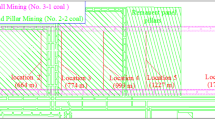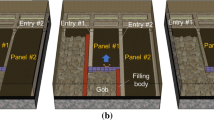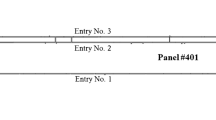Abstract
The room-and-pillar technique is a self-supporting mining method in which part of the ore is left unmined as pillars. To increase the mining efficiency, the pillars are later recovered partially or completely. This research aims at evaluating and comparing four methods of pillar recovery, namely, ‘pocket and wing’, ‘open ending’, ‘split and fender’, and ‘Christmas tree’ which are of particular importance. The performance of these methods of pillar recovery in the Tabas coal mine was evaluated by numerical modeling. To do this, a series of three-dimensional simulations were carried out in which the pillars were excavated according to the sequences specified by each method of recovery. The behavior of chain pillars, barrier pillars, and the roof was monitored and compared for the different cutting sequences. Using the shear strength reduction technique, the safety factor values were calculated during the different recovery methods until the verge of roof caving. The results revealed that the method of split and fender leads to a softer drop of the safety factor, and consequently, more controlled caving of the roof.














Similar content being viewed by others
Availability of data and materials
Some or all data, models, or codes that support the findings of this study are available from the corresponding author upon reasonable request.
References
ADAM Consulting Engineers (2005) Central mine design report.
Ajamzadeh M (2017) Selecting the suitable coal extraction machine for Parvadeh Tabas mechanized mine using Particle Flow Code. Hamedan University of Technology
Al Heib M, Duval C, Theoleyre F et al (2015) Analysis of the historical collapse of an abandoned underground chalk mine in 1961 in Clamart (Paris, France). Bull Eng Geol Env 74:1001–1018. https://doi.org/10.1007/s10064-014-0677-6
Chen S, Qu X, Yin D et al (2018) Investigation lateral deformation and failure characteristics of strip coal pillar in deep mining. Geomech Eng 14:421–428
Dawson EM, Roth WH, Drescher A (1999) Slope stability analysis by strength reduction. Geotechnique 49:835–840
Esterhuizen GS, Dolinar DR, Ellenberger JL (2011) Pillar strength in underground stone mines in the United States. Int J Rock Mech Min Sci 48:42–50
Fakhimi A, Hosseini O, Theodore R (2016) Physical and numerical study of strain burst of mine pillars. Comput Geotech 74:36–44
Feng G, Wang P (2020) Simulation of recovery of upper remnant coal pillar while mining the ultra-close lower panel using longwall top coal caving. Int J Min Sci Technol 30:55–61. https://doi.org/10.1016/j.ijmst.2019.12.017
Gao W (2018) Influence of interaction between coal and rock on the stability of strip coal pillar. Geomechanics and Engineering 16:151–157
Ghasemi E, Shahriar K (2012) A new coal pillars design method in order to enhance safety of the retreat mining in room and pillar mines. Saf Sci 50:579–585
Ghasemi E, Ataei M, Shahriar K et al (2012) Assessment of roof fall risk during retreat mining in room and pillar coal mines. Int J Rock Mech Min Sci 54:80–89
Itasca Consulting Group Inc. (2013) 3DEC user’s guide, Minneapolis. Minneapolis
Jessu KV, Spearing AJS (2019) Performance of inclined pillars with a major discontinuity. Int J Min Sci Technol 29:437–443. https://doi.org/10.1016/j.ijmst.2018.09.006
Kauffman PW, Hawkins SA, Thompson RR (1981) Room and pillar retreat mining. a manual for the coal industry.
Kim K-D, Lee S, Oh H-J (2009) Prediction of ground subsidence in Samcheok City, Korea using artificial neural networks and GIS. Environ Geol 58:61–70
Li X, Chai Y (2019) Determination of pillar width to improve mining safety in a deep burst-prone coal mine. Saf Sci 113:244–256. https://doi.org/10.1016/j.ssci.2018.12.003
Li H, Guo G, Zha J et al (2017) Stability evaluation method for hyperbolic coal pillars under the coupling effects of high temperature and ground stress. Environ Earth Sci 76:704. https://doi.org/10.1007/s12665-017-7048-0
Luo Y, Yang J (2018) Effects of dewatering flooded abandoned room-and-pillar mines on surface subsidence. Min Eng 70:45–50
Luo R, Li G, Chen L et al (2020) Ground subsidence induced by pillar deterioration in abandoned mine districts. J Central South Univ 27:2160–2172. https://doi.org/10.1007/s11771-020-4438-3
Satyanarayana I, Budi G, Murmu S (2021) Stability analysis of a deep highwall slope using numerical modelling and statistical approach—a case study. Arab J Geosci 14:179. https://doi.org/10.1007/s12517-021-06476-x
Shaojie C, Hailong W, Huaiyuan W et al (2016) Strip coal pillar design based on estimated surface subsidence in Eastern China. Rock Mech Rock Eng 49:3829–3838
Sun W, Zhang Q, Luan Y, Zhang X-P (2018) A study of surface subsidence and coal pillar safety for strip mining in a deep mine. Environ Earth Sci 77:627. https://doi.org/10.1007/s12665-018-7810-y
Waclawik P, Kukutsch R, Nemcik J (2018) Assessment of coal pillar stability at great depth. In: 18th Coal Operators’ Conference. pp 184–194
Yang JX, Liu CY, Yu B, Wu FF (2015) The effect of a multi-gob, pier-type roof structure on coal pillar load-bearing capacity and stress distribution. Bull Eng Geol Env 74:1267–1273. https://doi.org/10.1007/s10064-014-0685-6
Zhang Y, Ni P (2018) Design optimization of room and pillar mines: a case study of the Xianglushan tungsten mine. Q J Eng Geol Hydrogeol 51:352–364
Zhang J, Huang P, Zhang Q et al (2017) Stability and control of room mining coal pillars—taking room mining coal pillars of solid backfill recovery as an example. J Central South Univ 24:1121–1132. https://doi.org/10.1007/s11771-017-3515-8
Zhang P, Tulu B, Sears M, Trackemas J (2018) Geotechnical considerations for concurrent pillar recovery in close-distance multiple seams. Int J Min Sci Technol 28:21–27. https://doi.org/10.1016/j.ijmst.2017.12.012
Zhou Z, Wang H, Cai X et al (2020) Bearing characteristics and fatigue damage mechanism of multi-pillar system subjected to different cyclic loads. J Central South Univ 27:542–553. https://doi.org/10.1007/s11771-020-4315-0
Zhu D, Tu S (2017) Mechanisms of support failure induced by repeated mining under gobs created by two-seam room mining and prevention measures. Eng Fail Anal 82:161–178. https://doi.org/10.1016/j.engfailanal.2017.08.029
Zingano A, Weiss A (2019) Subsidence over room and pillar retreat mining in a low coal seam. Int J Min Sci Technol 29:51–57. https://doi.org/10.1016/j.ijmst.2018.11.022
Funding
No funding was received for conducting this study.
Author information
Authors and Affiliations
Corresponding author
Ethics declarations
Conflict of interest
The authors have no conflicts of interest to declare.
Additional information
Publisher's Note
Springer Nature remains neutral with regard to jurisdictional claims in published maps and institutional affiliations.
Rights and permissions
Springer Nature or its licensor (e.g. a society or other partner) holds exclusive rights to this article under a publishing agreement with the author(s) or other rightsholder(s); author self-archiving of the accepted manuscript version of this article is solely governed by the terms of such publishing agreement and applicable law.
About this article
Cite this article
Babanouri, N., Beyromvand, H. & Dehghani, H. Evaluation of different methods of pillar recovery in coal mining by numerical simulation: a case study. Environ Earth Sci 82, 110 (2023). https://doi.org/10.1007/s12665-023-10801-w
Received:
Accepted:
Published:
DOI: https://doi.org/10.1007/s12665-023-10801-w




